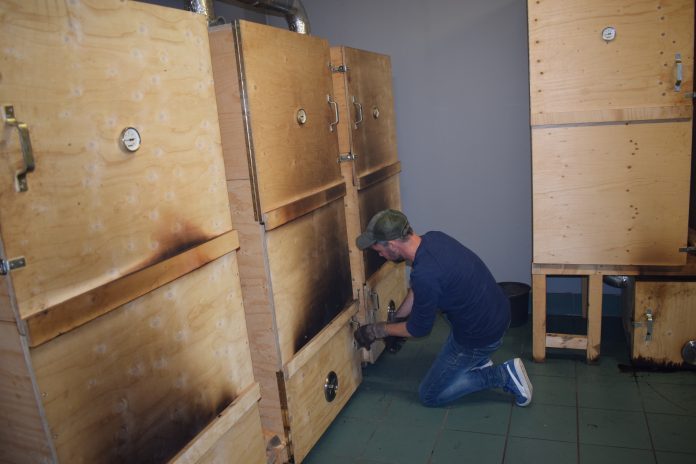Björn Zweers, of Zuidvenne smokehouse in the the Eastern Dutch city of Zutphen, tries to set a new standard: with wooden smokers, hand chopped wood and special salt from Brittany. Restaurants and consumers come from far to the shop to buy his traditionally smoked fish products.
Björn Zweers, owner of Zuidvenne smokehouse, started smoking fish as a hobby, while working as a process operator in several large factories.
“I started smoking trout in an oil drum in my backyard. I noticed that the temperature was constantly falling, due to the thin walls of the drum. So I came up with the idea to insulate it and built my first wooden smoker.”
Sel gris
He experimented further, with several types of smokewood and different kinds of salt.
“Salt is the most important seasoning for smoked fish. I started experimenting with sel gris, a type of sea salt from Brittany that has been extracted in salt pans for centuries. That salt contains no less than 72 minerals, including magnesium. The sedimentation in the salt pans gives a natural purification process. Sel gris has more flavour, also has 10 percent less sodium and is rich in magnesium, which lowers blood pressure.”

Zweers added other fish species, including mackerel, red gurnard and eel. In 2015 he quit his job and started smoking at fairs. Because of his background in the process industry, he wanted to know everything about temperature, influence of the duration of the salt bath and all other influences on the smoking process.
“I apply the technical knowledge I acquired in my previous profession in my current company. Sel gris, for example, has a different brine time then regular salt. And by trying and experimenting I have been able to develop smokers that emit 90 percent less CO2.”
His smokers – he now owns eight of them – are all made of wood.
“Wood insulates and keeps the temperature at an even level. Therefore you need less wood to get the smoker up to the right temperature. Because of the construction and the insulation value, I can keep my smokers at the ideal smoking temperature of 40 degrees for a very long time, without having to check them.”
Traditional and sustainable
In 2016 Zweers got the chance to take over a smokehouse at the Dutch island of Terschelling.
“That company also smoked salmon, so I was introduced to the process of cold smoking. The previous owner obtained his raw material for the smoked salmon from Norway. I started looking for a supplier who could supply salmon from the Faroe Islands. That’s where I get my mackerel, from an MSC-certified fishery. I think sustainable farming, production methods and fishing are very important. I try to set a new standard, by being innovative and keeping the ecological footprint of my company as small as possible.”
Oak and beech wood
A year ago Björn Zweers moved the smokehouse to Zutphen, his hometown. Meanwhile,  his knowledge about and experience with the smoking process has grown considerably.
his knowledge about and experience with the smoking process has grown considerably.
“The quality of my products has improved enormously. I now supply Michelin restaurants in the area. When I opened my company here in Zutphen eleven months ago, I got coverage in three different newspapers, which resulted in interest from many restaurants. Top restaurants nowadays all want to buy locally. Zuidvenne is the only smokehouse in 50 kilometres perimeter with all the necessary permits and sufficient quality, so that worked very well for me.”
Björn Zweers chops his smokewood himself to the desired size.
“The ready to use smoked wood chips are very small. As a result, they burn too quickly. The wood has to keep smouldering for a long time. That’s why I prefer wood from young trees, between 40 and 60 years old. They have a harder core, the rings are very compact. This gives the wood more aromas: the taste is stronger and you need less wood.”
He smokes his salmon with a mixture of oak and cedar wood. “I want to replace the latter with grape wood soon, in order to have entirely local woods. I am a member of the Slow Food Youth Network and currently follow the sustainability programme there. By participating in this programme you get all kinds of tips on how to increase the sustainability of your company. Affiliated companies give each other feedback on sustainable entrepreneurship.”
Holiday Season
Zweers recently developed a new product: baking salmon. “Mildly salted and smoked shorter; it remains nicely rosé on the inside. It is my alternative for hot smoked salmon. By briefly baking it at home you get the same effect as hot smoked salmon, but tastier and more tender.”
 Zweers has been preparing for the holidays since November.
Zweers has been preparing for the holidays since November.
“Last year, demand for smoked salmon tripled during the holidays. It was quite a challenge to get it all done and get extra raw material on short notice. This year I was well prepared.”
In addition to smoked salmon, his offer for the holidays consists of salads with mackerel and salmon. His customer base consists of restaurants, hotels, caterers and direct consumers.
“As a small entrepreneur I need to have a broad customer base. The private market is interesting for me. Consumers pay immediately, which is less of a risk for me as a small player. The restaurants I deliver put the name of my company on the menu. This also immediately results in new customers, who order via my web shop or come to the store.”
“In the end I want to get the fish sector moving. Consumers are becoming more critical of what they eat because of all the food scandals, such as listeria contamination of smoked salmon. They are also concerned about the ecological impact of the products they consume. We only have to respond to it and take our responsibility as entrepeneurs, by producing and selling good, sustainable and local products.”

